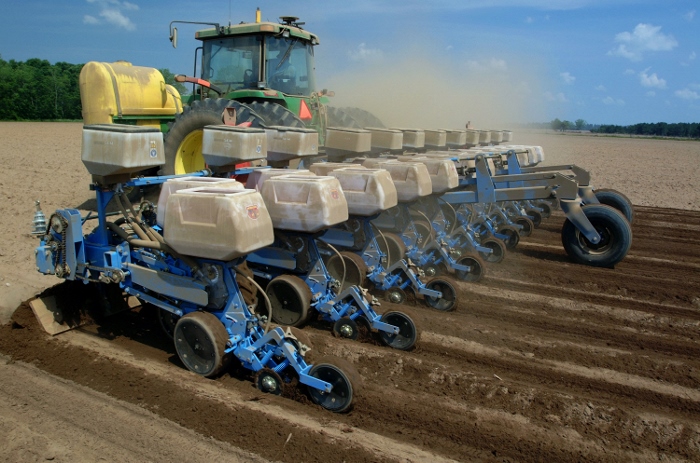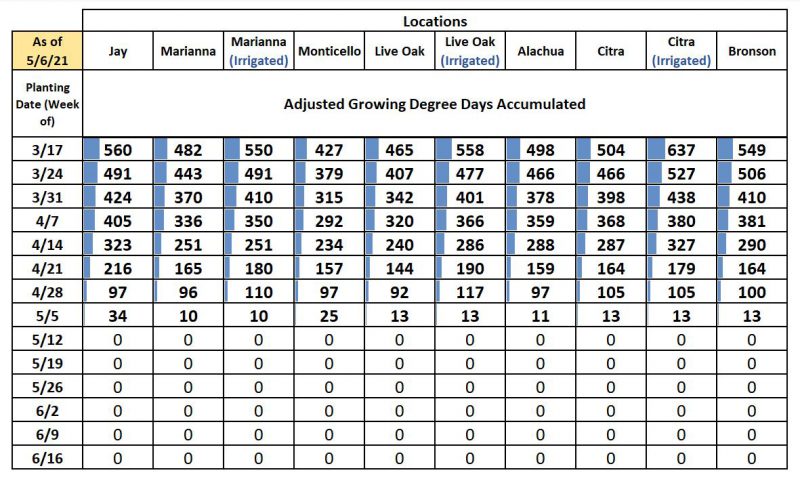
Track peanut crop development and maturity from the beginning of the season to optimize harvest timing.
Photo credit: IFAS Communications
Mark Mauldin, Ag & Natural Resources Agent Washington County, Dr. Barry Tillman Peanut Breeder UF/IFAS NFREC, and Camila Ichazo
This year’s peanut seeds may have just gone into the ground, but it’s never too early to take steps to maximize your crop’s yield and grade. Making sure peanuts are harvested at optimum maturity is one of the crucial steps. To take this step you must effectively track the crops maturity. While days after planting (DAP) is commonly used to quantify peanut maturity, it is not the most accurate unit of measure available, so DAP should not be the sole criteria used to determine harvest date.
Environmental factors, primarily temperature and moisture availability, not the calendar, drive how fast a peanut crop matures. Adjusted Growing Degree Day (aGDD) is a unit that accounts for these factors. Depending on environmental conditions, a field will accumulate aGDDs at a different rate each calendar day, and at a different rate than other fields experiencing different environmental conditions. A peanut crop will fully mature with approximately 2500 aGDDs. Tracking the number of aGDDs accumulated by a specific field allows you to effectively track its maturity.
A couple of concepts to help illustrate the importance of tracking maturity with aGDDs:
- Planting date can affect how fast aGDDs are accumulated shortly after planting – lower air and soil temperatures associated with early plantings slow the accumulation compared to fields planted later in the season.
- Even slight drought stress slows the accumulation of aGDDs – this means frequency of rainfall (or irrigation) and soil type can affect how fast the crop matures. This situation can become very evident in rain-fed fields when summer showers are hit-and-miss.
–
To help illustrate how aGDDs accumulate throughout the season, and to provide growers with an approximation of how their fields should be progressing, in terms of aGDDs, the Florida Peanut Team will be sharing this aGDD Tracker throughout the season. The aGDD Tracker is essentially a table that shows the accumulation of aGDDs for a wide range of planting dates at locations across the peanut producing region of the state.
The aGDDs shown on the aGDD Tracker are calculated by the Peanut Field Agronomic Resource Manager (PeanutFARM http://peanutfarm.org/). The weather data (daily upper and lower temperature and rainfall) used in the aGDD calculation is generated by the corresponding Florida Automated Weather Network (FAWN) station. Growers are advised to set-up their own fields in PeanutFARM to allow more accurate calculation of aGDD for each field. This will enable producers to enter their own, field specific, rainfall and/or irrigation data. Temperature data will be provided by the FAWN station closest to the field. Start setting-up fields soon, so you can stay on top of the rainfall/irrigation data. PeanutFARM is also a valuable irrigation scheduling tool. There is no cost to use PeanutFARM. If you need assistance getting started with PeanutFARM contact your county’s Agriculture Extension Agent.
Just like DAP should not be the only factor determining when peanuts are harvested, aGDDs calculated by PeanutFARM should not be the sole deciding factor either. Once your field, or the closet approximation on the aGDD Tracker, reaches 2300 aGDDs, good representative samples should be collected, and the crops actual physiological maturity should be determined via pod-blasting. This final step will provide you with an exact recommendation of days to harvest. Most UF/IFAS Extension Offices, in peanut producing counties, offer pod-blasting services.
- Peanut Maturity Update – 10/9/25 - October 10, 2025
- Fall Can be a Great Time for Vegetation Management - October 3, 2025
- Peanut Maturity Update – 9/25/25 Edition - September 26, 2025

